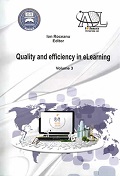ORIGINAL ASPECTS REGARDING THE PSYCHOMOTOR EVALUATION OF THE PRIMARY SCHOOL STUDENTS
ORIGINAL ASPECTS REGARDING THE PSYCHOMOTOR EVALUATION OF THE PRIMARY SCHOOL STUDENTS
Author(s): Bogdan Gozu, Marius StoicaSubject(s): Education
Published by: Carol I National Defence University Publishing House
Keywords: motor proficiency age; chronological age; primary school; manual dexterity; bilateral coordination
Summary/Abstract: Problem Statement. The study of the main factors specific to the psychomotor phenomenon (in this case, aspects related to manual dexterity and bilateral coordination), as well as of the connections between those factors in relation to the subjects’ chronological age. Purpose. Our experiment envisages an analysis of the connection between motor proficiency age and chronological age in primary school students, based on the information provided by the Bruininks-Oseretsky Test - Second Edition (BOT-2) applied for the first time in Romania. Methods. Forty subjects were selected to participate in this research experiment (20 boys and 20 girls), 1st up to 4th grade students, coming from urban and rural areas alike. The subjects’ evaluation took place from March 20, 2010 until June 4, 2010 and consisted in the application of 12 test items specific to manual dexterity and bilateral coordination subtests provided by the Bruininks-Oseretsky Test, Second Edition. In terms of computer software and specific tools used for statistical analysis of the obtained data, the following instruments were used: BOT-2 ASSISTTM, Scoring and Reporting System (integrated software of the Bruininks-Oseretsky Test - Second Edition), MINITAB 15.1 of MINITAB Inc. and MICROSOFT EXCEL 2003. Results and discussions. The tests revealed that with respect to manual dexterity, the average motor proficiency age (10 years and 5 months) was higher by 1 year and 2 months than the average chronological age of the tested subjects (9 years and 3 months), while the verification of the statistical hypothesis through the dependent T-Test revealed a statistically significant difference of means (P=0.009 is smaller than 0.05). Regarding the bilateral coordination subtest, the average motor proficiency age (8 years and 7 months) is lower by 8 months than the average chronological age (9 years and 3 months), and in this case the verification of the statistical hypothesis performed through the same test, revealed a statistically significant difference of means as well (P=0.019 is smaller than 0.05). Conclusions. The analysis of the results obtained by the tested subjects allows us to confirm the research hypothesis regarding the manual dexterity and bilateral coordination subtests. We can conclude as well that the use of the Bruininks-Oseretsky Test - Second Edition, for the first time in Romania, within an experimental research, represents, besides an original approach, a major opportunity of obtaining extremely valuable data regarding several psychomotor characteristics of primary school students.
Journal: Conference proceedings of »eLearning and Software for Education« (eLSE)
- Issue Year: 9/2013
- Issue No: 03
- Page Range: 167-172
- Page Count: 6
- Language: English

